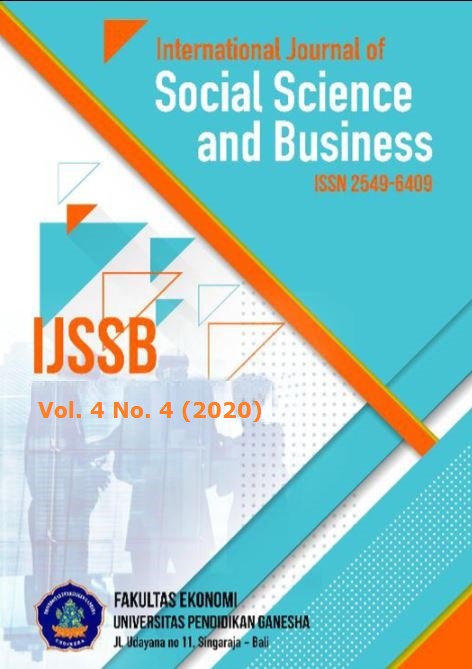The Roles of Sensory Attributes, Functional Benefit, and Brand Ambassador Toward the Brand Loyalty and Repurchase Intention of a Coffee Brand
DOI:
https://doi.org/10.23887/ijssb.v4i4.28156Keywords:
Sensory attributes, functional benefits, brand ambassador, repurchase intention, brand loyaltyAbstract
The trend of drinking coffee has resulted in an increase of coffee consumption around the world, including Indonesia. This study investigates the roles of sensory attributes, functional benefit, and brand ambassador towards the intention to repurchase which leads to brand loyalty of Luwak White Coffee. This study uses a quantitative approach by using primary data and distributed questionnaires to 100 employees of various corporations in Jakarta. The data was analyzed through regression analysis. The result of this study shows that functional benefit has a significant influence on both intentions to repurchase and brand loyalty. This benefit factor is the most important precedent to both repurchase intention and brand loyalty. On the other hand, sensory attributes do not affect repurchase intention. This type of information can be important to predict or to explain the market response to luwak coffee products, and also to select which sensory attribute should be included in a sensory specification or must be considered in product quality control programs. Another important finding is that, contrary to our expectations, we do not find empirical support for the significant influence of brand ambassador on an intention to repurchase and brand loyalty. The explanation may be that customers currently expect the functional benefit in the form of healthier gastric-friendly white coffee. Moreover, the brand ambassador may not be too influential in the high buying decision among luwak coffee consumers. The relevant contributions that emerged from this study include not only bridging the aforementioned gap in the literature but also offering significant managerial implications to assist organizations to understand the importance of functional benefits toward repurchase intention and brand loyalty.
References
Al-Shuhaibi, A. S. I., Shamsudin, F. M., & Aziz, N. A. (2016). Developing Brand Ambassadors: The Role of Brand-centred Human Resource Management. International Review of Management and Marketing, 6, 155–161. https://www.econjournals.com/index.php/irmm/article/view/3225
Alfirahmi, A. (2019). Fenomena Kopi Kekinian di Era 4.0 ditinjau dari Marketing 4.0 dan teori Uses and Effect. Lugas: Jurnal Komunikasi, 3(1), 24–32. https://doi.org/10.31334/ljk.v3i1.410
Barahona, I., Jaimes, E. M. S., & Yang, J.-B. (2020). Sensory attributes of coffee beverages and their relation to price and package information: A case study of Colombian customers’ preferences. Food Science & Nutrition, 8(2). https://doi.org/10.1002/fsn3.1404
Baron, R. M., & Kenny, D. A. (1986). The moderator-mediator variable distinction in social psychological research: Conceptual, strategic, and statistical considerations. Journal of Personality and Social Psychology, 51(6), 1173–1182. https://psycnet.apa.org/1987-13085-001
Brakus, J. J., Schmitt, B. H., & Zarantonello, L. (2009). Brand Experience: What Is It? How Is It Measured? Does It Affect Loyalty? Journal of Marketing, 73(3), 52–68. https://doi.org/10.1509/jmkg.73.3.052
Consuegra, Martin, D., Molina, A., & Esteban, A. (2007). An integrated model of price, satisfaction and loyalty: An empirical analysis in the service sector. Journal of Product & Brand Management, 16(7), 459–468. https://doi.org/10.1108/10610420710834913
Curtis, T., Abratt, R., & Rhoades, D. L. (2011). Customer Loyalty, Repurchase and Satisfaction: A Meta-Analytical Review. Journal of Consumer Satisfaction, Dissatisfaction and Complaining Behavior, 24(1), 1–26. https://commons.erau.edu/db-management/18/
Durmaz, Y., Cavusoglu, S., & Ozer, O. (2018). The effect of brand image and brand benefit on customer loyalty: the case of Turkey. International Journal of Academic Research and Social Sciences, 8(5), 528–540. https://ideas.repec.org/a/hur/ijarbs/v8y2018i5p528-540.html
Gogtay, N. J., & Thatte, U. M. (2017). Principles of Correlation Analysis. Journal of The Association of Physicians of India, 65, 78–81. https://www.kem.edu/wp-content/uploads/2012/06/9-Principles_of_correlation-1.pdf
Gupta, K., & Stewart, D. W. (1996). Customer Satisfaction and Customer Behavior: The Differential Role of Brand and Category. Marketing Letters, 7(3), 249–263. https://doi.org/10.1007/BF00435741
Gwinner, K. P., Gremler, D. D., & Bitner, M. J. (1998). Relational benefits in service industries: The customer’s perspective. Journal of the Academy of Marketing Science, 26(2), 101–114. https://doi.org/10.1177/0092070398262002
Harris, F., & de Chernatony, L. (2001). Corporate branding and corporate brand performance. European Journal of Marketing, 35(3/4), 441–456. https://doi.org/10.1108/03090560110382101
Jaimes, E. M. S., Torres, I. B., & Perez-Villareal, H. H. (2015). Sensory evaluation of commercial coffee brands in Colombia. International Journal of Business and Systems Research, 9(3), 195–213. https://doi.org/10.1504/IJBSR.2015.071831
Knox, S., & Walker, D. (2001). Measuring and Managing Brand Loyalty. Journal of Strategic Marketing, 9(2), 111–128. https://doi.org/10.1080/713775733
Ko, E., Lee, M.-A., Lee, M. Y., Phan, M., Kim, K. H., Hwang, Y. K., & Burns, L. D. (2011). Product Attributes’ Effects on Perceived Values and Repurchase Intention in Korea, USA, and France. Journal of Global Scholars of Marketing Science, 21(3), 155–166. https://doi.org/10.1080/21639159.2011.9711022
Orth, U. R., & DeMarchi, R. (2007). Understanding the Relationships between Functional, Symbolic, and Experiential BrandBeliefs, Product Experiential Attributes, and Product Schema: Advertising-Trial Interactions Revisited. Journal of Marketing Theory and Practice, 15(3), 219–233. https://doi.org/10.2753/MTP1069-6679150303
Sayed, M. A. (2015). Does Brand Experience Build Customer’s Satisfaction and Loyalty in the Automobile Industry. Journal of Marketing and Consumer Research, 15(1), 103–112.
So, J., Parsons, A., & Yap, S. (2013). Corporate branding, emotional attachment and brand loyalty: the case of luxury fashion branding. Journal of Fashion Marketing and Management: An International Journal, 17(4), 403–423. https://doi.org/10.1108/JFMM-03-2013-0032
Utami, E. S. (2016). Pengaruh Brand Awareness sebagai Mediasi Pengaruh Iklan Televisi Dan Brand Ambassador Terhadap Repuchase Intention Produk Kecantikan Wardah. Jurnal Ilmiah Mahasiswa FEB Universitas Brawijaya, 5(2).
Wiedmann, K.-P., Hennigs, N., & Siebels, A. (2007). Measuring Consumers’ Luxury Value Perception: A Cross-Cultural Framework. Academy of Marketing Science Review, 7(1), 1–21. https://www.questia.com/library/journal/1G1-177719439/measuring-consumers-luxury-value-perception-a-cross-cultural
Wijaya, R., Farida, N., & Andriansyah. (2018). Determinants of Repurchase intentions at Online Stores in Indonesia. International Journal of E-Business Research, 14(3), 95–111.











